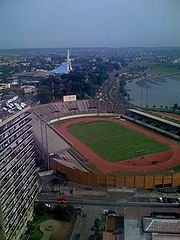
Stade Félix Houphouët-Boigny
Encyclopedia

Stade Félix Houphouët-Boigny, nicknamed "le Félicia", is a multi-purpose stadium, which can host football, rugby and athletics, in Abidjan
Abidjan
Abidjan is the economic and former official capital of Côte d'Ivoire, while the current capital is Yamoussoukro. it was the largest city in the nation and the third-largest French-speaking city in the world, after Paris, and Kinshasa but before Montreal...
, Côte d'Ivoire
Côte d'Ivoire
The Republic of Côte d'Ivoire or Ivory Coast is a country in West Africa. It has an area of , and borders the countries Liberia, Guinea, Mali, Burkina Faso and Ghana; its southern boundary is along the Gulf of Guinea. The country's population was 15,366,672 in 1998 and was estimated to be...
. It is the national stadium of the Côte d'Ivoire national football team
Côte d'Ivoire national football team
The Côte d'Ivoire National Football Team or Ivory Coast National Football Team, nicknamed Les Éléphants , represents Côte d'Ivoire in international football and is controlled by the Fédération Ivoirienne de Football...
. It is named after the first president of the country, Félix Houphouët-Boigny
Félix Houphouët-Boigny
Félix Houphouët-Boigny , affectionately called Papa Houphouët or Le Vieux, was the first President of Côte d'Ivoire. Originally a village chief, he worked as a doctor, an administrator of a plantation, and a union leader, before being elected to the French Parliament and serving in a number of...
, and is located in the Plateau of Abidjan. The stadium has a capacity of 35,000 which can be expanded to 40,000. It also receives matches of the ASEC Abidjan.
History
Built in 1964 to organize the "Games of Abidjan", the stadium was formerly known as Stade Andre Geo, and it took the name of the President Felix Houphouet-Boigny and undergoing restoration.Gradually it emerged as the National Stadium, hosting the ASEC Mimosas and Ivorian Soccer Team.
With the Stadium of Peace of Bouake, Stade Felix Houphouet-Boigny Hosts Africa Cup of Nations soccer. In 2009After a complete renovation, including lawn seating or treatment room, the stadium hosts the African Championship of Nations.
The stadium played host to Amnesty International
Amnesty International
Amnesty International is an international non-governmental organisation whose stated mission is "to conduct research and generate action to prevent and end grave abuses of human rights, and to demand justice for those whose rights have been violated."Following a publication of Peter Benenson's...
's Human Rights Now! Benefit Concert on October 9, 1988. The show was headlined by Sting and Peter Gabriel
Peter Gabriel
Peter Brian Gabriel is an English singer, musician, and songwriter who rose to fame as the lead vocalist and flautist of the progressive rock group Genesis. After leaving Genesis, Gabriel went on to a successful solo career...
and also featured Bruce Springsteen
Bruce Springsteen
Bruce Frederick Joseph Springsteen , nicknamed "The Boss," is an American singer-songwriter who records and tours with the E Street Band...
& The E Street Band
E Street Band
The E Street Band has been rock musician Bruce Springsteen's primary backing band since 1972.The band has also recorded with a wide range of other artists including Bob Dylan, Meat Loaf, Bonnie Tyler, Air Supply, Dire Straits, David Bowie, Peter Gabriel, Stevie Nicks, Tom Morello, Sting, Ian...
, Tracy Chapman
Tracy Chapman
Tracy Chapman is an American singer-songwriter, best known for her singles "Fast Car", "Talkin' 'bout a Revolution", "Baby Can I Hold You", "Give Me One Reason" and "Telling Stories". She is a multi-platinum and four-time Grammy Award-winning artist.-Biography:Tracy Chapman was born in Cleveland,...
and Youssou N'Dour
Youssou N'Dour
Youssou N'Dour is a Senegalese singer, percussionist and occasional actor. In 2004, Rolling Stone described him as, in Senegal and much of Africa, "perhaps the most famous singer alive." He helped develop a style of popular music in Senegal, known in the Serer language as mbalax, a type of music...
.
On March 29, 2009, during the match between Ivory Coast and Malawi, the gateway to an open corner of the stadium gave way before the kick-off of the match. A stampede ensued, killing 19 people by trampling and over 130 were injured.
Structure
The stadium has an estimated capacity of between 35,000 and 40,000 seats due to not being an all-seater stadium. The bleachers painted in national colors consist of curves, the gallery lagoon side of the podium, a gallery and a presidential box, VIP, and BVIP .The stage contains a media room, a room control anti-doping, a VIP room, a treatment room, offices of arbitrators, a massage room, not to mention four dressing rooms.
The stadium has a video board 220 volts for 35 kwh, 16.50 meters by 5.70 meters.
The lawn is of international standard and is maintained daily green and glowing.

